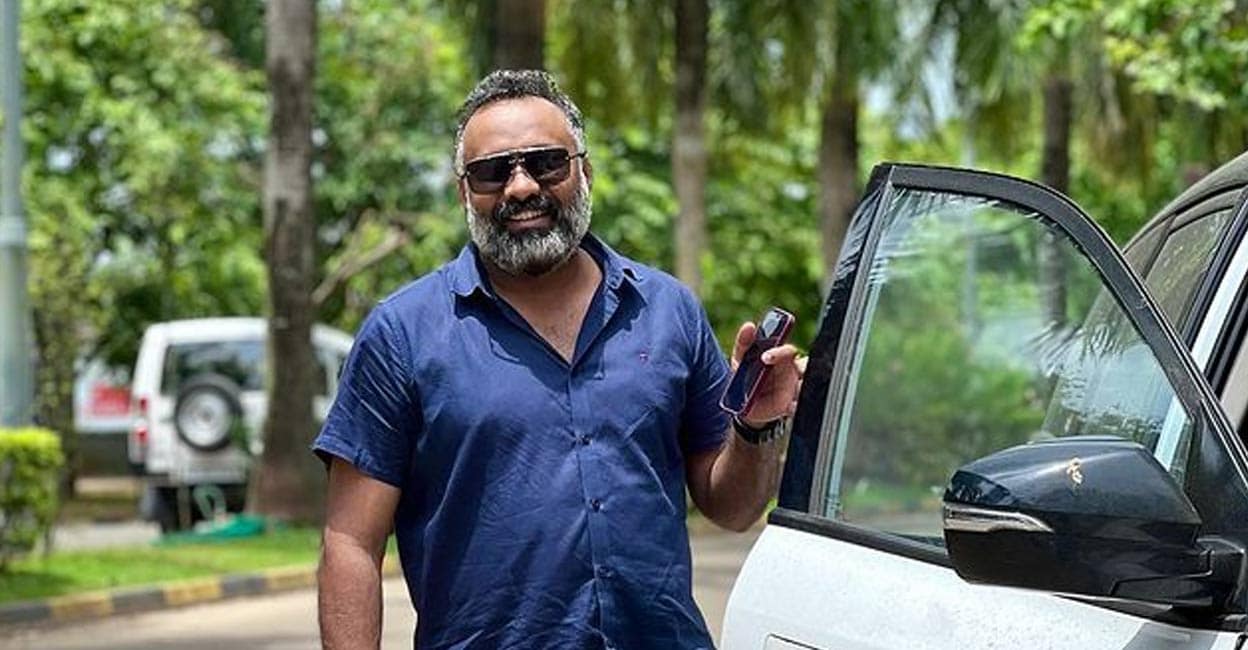
Investing in children’s well-being: The urgent need for expanded mental health and psychosocial support funding World Economic Forum
source

Follow Whatsapp Channel
Onmanorama Staff
Published: December 20 , 2024 03:21 PM IST
1 minute Read
Link Copied
Kochi: The Kerala High Court on Friday granted bail to Malayalam movie director Omar Lulu in connection with a rape case. Justice P V Kunhikrishnan, in his ruling, noted that prima facie, the relationship between the director and the complainant appeared to be consensual. However, the court added that the investigating officer may continue the investigation into the matter, reported LiveLaw.
"I don’t want to make any observations about the merits of the case because an investigation is ongoing. But, prima facie I am of the opinion that it was a consensual relationship between the parties. But I make it clear that the investigating officer is free to investigate the matter and collect materials. But this is a fit case in which the petitioner is to be released on bail invoking the powers under Section 438 of Criminal Procedure Code," the Justice said.
Omar Lulu was booked under Section 376 of IPC based on the complaint given by the victim. He denied the allegations, saying that they were in a consensual relationship. The director presented proof of their stay in various hotels in and around Kochi. He showed that both of their ID cards were used to get a room in one of the hotels.
A young Malayalam actor lodged a sexual harassment complaint against Lulu, alleging that he raped her multiple times after promising her a role in a film. The statement was recorded by the Nedumbassery police.
© Copyright 2024 Onmanorama. All rights reserved.

Investors seeking affordable yet promising cryptocurrencies are turning their attention to five standout altcoins priced under $1, each poised for explosive growth in 2025. Kaspa, Stellar, Rollblock, TRON, and Hedera offer innovative solutions and strong use cases, making them top contenders for significant breakouts. These low-cost coins combine cutting-edge technology with high growth potential, attracting savvy traders eager to capitalize on the next crypto surge. Discover why these altcoins are worth adding to your portfolio.
Rollblock is emerging as a top investment opportunity for traders seeking up to 100x returns in early 2025. Combining the best features of centralized and decentralized gaming, Rollblock operates on its Ethereum-backed ecosystem, drawing significant investments from Bitcoin whales during Stage 9 of its presale. Analysts predict up to 880% returns for early investors before the token officially launches on the open market.
Traders are excited about Rollblock because it prioritizes trust and transparency. Unlike traditional iGaming platforms, Rollblock ensures secure and fair gameplay through Ethereum-backed encryption. Every transaction is recorded on the blockchain, ensuring users’ data is protected from third-party interference.
Rollblock also rewards its investors through a revenue-sharing model. Traders who provide liquidity can earn weekly passive income with staking rewards of up to 30% APY. This mechanism, combined with a buyback and burn system, is expected to cause a deflationary effect on the $RBLK token, increasing its value over time. Each week, a portion of Rollblock’s profits will repurchase $RBLK tokens, with 60% permanently destroyed and the remainder supporting the staking community.
Kaspa (KAS) continues to gain attention as a high-performance Layer-1 blockchain, using its innovative blockDAG architecture to enhance scalability and speed. Over the past month, Kaspa has risen by 2.8%, reaching a price of $0.15. The token shows strong momentum, backed by institutional interest and positive short-term chart indicators.
Analyst Alex Clay recently tweeted about a potential 5x breakout for Kaspa after 371 days of accumulation. The analyst outlined price targets for traders to watch for Kaspa, including $0.280430, $0.395145, and $0.511035. Chart analysis confirms this optimism with a healthy upward trendline that will probably offer support for Kaspa in the long term.
Stellar has seen a 30-day price increase of 140.98% because of the Bitcoin rally. Analysts believe this upward momentum isn’t over. EGRAG CRYPTO, a prominent analyst, notes that Stellar’s current price movement resembles its explosive rise in 2020 when it broke above its EMA and surged by 3,100%. EGRAG predicts that Stellar could rally by 360%, reaching $2.27 in the coming weeks.
Currently trading at $0.4524, Stellar has seen a 0.99% increase during the day. The altcoin’s trading volume has risen by 46.15%, indicating a potential shift in market control to buyers. With Stellar’s RSI remaining neutral, analysts think there’s still time to grow before Q4 ends as Bitcoin will continue to trade above $100k.
TRON’s price suffered a correction following a 100% rally last week. The surge occurred after the introduction of martial law in South Korea pushed investors away from centralized markets. As one of the largest decentralized exchange platforms, TRON became a primary choice for these investors.
However, the rally quickly reversed as the political situation in South Korea calmed. TRON dropped 35% this week and now shows less than 30% net growth from its previous rally. The altcoin has been losing value since reaching an all-time high of $0.42 in early December.
Despite this, TRON recently saw a 1,900% increase in DeFi transaction volume. The token’s trading volume remains strong, with billions of dollars traded daily. However, these positive metrics haven’t been enough to offset the weak price performance. TRON is now trading around $0.25 and further price corrections could cause a sell-off.
Hedera’s price soared in the last few weeks, bringing its market cap to over $10.8 billion. But the token is currently below its 50-day moving average. Hedera’s price has jumped more than 800% since November 2024 though the price needs more aggressive investor interest.
Despite its innovative technology and partnerships with major players like Google and IBM, Hedera struggles to maintain its gains. By 2025, experts project Hedera to be worth $0.63 to $0.76. However, for now, Hedera’s growth is slowed by weakening sentiment and short-term resistance.
Kaspa, Stellar, Tron and Hedera are all top altcoins. However, none of these altcoins possess as many unique offerings as Rollblock. Rollblock’s GameFi model and revenue-sharing model are set to attract holders of Kaspa, Stellar, Tron, and Hedera in 2025.
The presale price of $0.0415 is expected to rise rapidly, as experts predict a 50x rally due to a potential supply crunch. Rollblock has also strengthened its credibility by updating its gaming license with Gaming Anjouan, further solidifying its potential to disrupt the gaming industry.
Discover the exciting opportunities of the Rollblock (RBLK) presale today!
Website: https://presale.rollblock.io/
Socials: https://linktr.ee/rollblockcasino
Disclaimer: This is a paid release. The statements, views and opinions expressed in this column are solely those of the content provider and do not necessarily represent those of Bitcoinist. Bitcoinist does not guarantee the accuracy or timeliness of information available in such content. Do your research and invest at your own risk.
For updates and exclusive offers enter your email.
Bitcoinist is the ultimate news and review site for the crypto currency community!
Bitcoin news portal providing breaking news, guides, price analysis about decentralized digital money & blockchain technology.
© 2023 Bitcoinist. All Rights Reserved.

Disclaimer: The opinions expressed by our writers are their own and do not represent the views of U.Today. The financial and market information provided on U.Today is intended for informational purposes only. U.Today is not liable for any financial losses incurred while trading cryptocurrencies. Conduct your own research by contacting financial experts before making any investment decisions. We believe that all content is accurate as of the date of publication, but certain offers mentioned may no longer be available.
Billy Markus, one of the two founders of the original meme cryptocurrency Dogecoin launched in 2013, has published a post where he commented on the massive price fall faced by Bitcoin, Ethereum, and Dogecoin, along with the rest of the crypto market over the last 24 hours.
On social media Markus is widely known under the alias Shibetoshi Nakamoto. In this post, the popular ‘WAGMI’ acronym was mentioned, which is supposed to be bullish and optimistic.
Known for his playful, ironic and, frequently, sarcastic comments related to crypto market volatility, Markus responded in his typical manner. Publishing a post with a chart, where three top ten cryptocurrencies, including one created by him – Bitcoin, Ethereum, and Dogecoin – Markus wrote in his X post in capitals: “SO GLAD I QUIT MY JOB.”
SO GLAD I QUIT MY JOB pic.twitter.com/5GDztFIJal
In that screenshot, Bitcoin dropped below the $98,000 level but in the past hour, the world’s flagship crypto has extended its crash by going down to $96,076 per coin. Overall, since Thursday, this constitutes a 6.45% decline from the $102,000 price mark.
Shibetoshi Nakamoto’s brainchild Dogecoin has crashed harder, falling by almost 17% from $0.36668 to $0.30491, where it is currently changing hands.
The second biggest cryptocurrency by market cap, Ethereum, has experienced an 11.2% crash, rapidly declining from $3,711 to $3,301 as of this writing.
The crypto market has faced stunning losses as $1.2 billion worth of crypto has been wiped out. Among those, the liquidations of long positions constituted the majority of the losses – $1.07 billion triggered by the speech of the Fed Reserve chairman Jerome Powell that the US central bank intends to drastically reduce interest rate cuts. The next coming easing is to be 25 basis points rather than 100 as was expected by crypto fans and the financial community in general.
In the comment thread, an X user wrote a popular acronym WAGMI, which means “we’re all gonna make it” used for encouraging and adding optimism in troublesome periods of time not only concerning the crypto or traditional financial markets but events in the world and individual lives in general.
Shibetoshi Nakamoto reacted by posting an animated GIF to agree with that statement. But that response also seems rather ironic.
pic.twitter.com/X0d1zOIJWu
Disclaimer: The opinions expressed here are not investment advice; they are provided for informational purposes only. The opinions expressed by our writers are their own and do not represent the views of U.Today. Every investment and all trading involves risk, so you should always perform your own research prior to making decisions. U.Today is not liable for any financial losses incurred while trading cryptocurrencies. We do not recommend investing money you cannot afford to lose.

Complete your personal information for a more tailored experience
Home
Don't miss out
Subscribe to STAT+ today, for the best life sciences journalism in the industry
By Annalisa Merelli
Dec. 20, 2024
General Assignment Reporter
Too many new moms are dying in the U.S.
Exactly how many, however, is harder to establish.
After years of neglect, the issue of maternal mortality is finally getting attention in policy and politics, as well as in the media, with headlines drawing attention to figures that show the maternal mortality rate has, at least according to some measurements, doubled in the past two decades.
advertisement
But some recent papers and media stories have questioned whether the crisis is more one of perception, raising concerns about whether overcounting and poor data have led to fear-mongering. An essay published in The Atlantic, criticizing the “doom and gloom” attitude about the state of maternal health in the U.S., argued: “Things aren’t getting worse for women; we’re just getting better at tracking what’s going on.”
It’s true that the data varies: Various sources estimate that the rate of maternal mortality per 100,000 live births in 2020 was 23.8 (per the Centers for Disease Control and Prevention’s National Vital Statistics System); 24.9 (according to the CDC’s Prevention’s Pregnancy Mortality Surveillance System); and 18.4 (according to the 38 states reporting to the CDC’s Maternal Mortality Review Committee). Some data sources classify deaths as maternal mortality only up to 42 days postpartum, while others categorize them as such up to a year after the person has given birth. Variations in death certificates over time make accurate historical comparisons impossible. And the absolute numbers of maternal deaths are small enough (typically under a thousand per year, and 861 in 2020) that even one or two miscategorized deaths make a difference.
Yet even without definitive data, there are undeniable facts. Maternal mortality in the U.S. is several times higher than in comparable countries. Racial inequity plays a huge role in maternal health outcomes. And Black women in particular face three to four times the risk of dying of pregnancy-related causes than their white counterparts, irrespective of their income or educational status.
advertisement
The upshot: Improving maternal data collection and analysis is important. But experts who study the issue say that shouldn’t overshadow the fundamental work of understanding why maternal mortality deaths are happening and how they can be prevented.
“We can’t let ourselves get distracted by discrepancies around data and distract ourselves from how poorly we perform in the United States, and also the extent to which there are disparities across different, racial groups, payer groups, language groups,” said Amanda Williams, clinical innovation advisor at the California Maternal Quality Care Collaborative, an organization co-founded in 2005 by the state of California and Stanford University to improve maternal health.
“By any standard, we really have a problem,” said Eugene Declerq, a professor of community health sciences at the Boston University School of Public Health and a leading maternal mortality data expert. “And you can’t solve it by ignoring it.”
While data is important, experts say, so is the qualitative side of maternal mortality — that is, not just whether or not a new mother died, but how, and why, and what led to such an outcome.
This side of the issue is perhaps best captured by the work of state maternal mortality review committees, which serve as medical and social investigation teams, taking every case reported as a potential maternal death in a state — even in very large states, deaths are rarely more than 100 per year — and studying whether it could be considered a maternal death, and if it could have been avoided.
The key question is whether the person would have died had she not gotten pregnant in the previous year. “And trying to determine that in a death that happens five months after the baby was born is really, really challenging,” said Declercq, who sits on the Massachusetts review committee. “Then we also have to wrestle with, ‘was it preventable?’ And you often end up with this dilemma: it would be preventable if we had a functional social system that helped take care of her back when she was 17 and first started having a problem with drugs.”
advertisement
Such questions apply to many other potential causes of death. A woman who is killed by her domestic partner: Was her being pregnant, or a new mother, a factor? A new mother falls asleep at the wheel after work: Would parental leave have prevented her death?
Understand how science, health policy, and medicine shape the world every day
Your data will be processed in accordance with our Privacy Policy and Terms of Service. You may opt out of receiving STAT communications at any time.
Maternal health advocates believe that one reason it took so long for these deaths to be acknowledged as a serious health issue is that maternal mortality sits at the intersection of many systemic ills: racism, economic inequality, poor access to health care, misogyny.
Addressing maternal mortality “was never about one thing — it’s about a revolution,” said Joia Crear-Perry, the founder and president of the National Birth Equity Collaborative, one of the country’s leading maternal health advocacy and policy organizations.
Focusing on data accuracy in order to argue that maternal mortality concerns have been overblown can even be understood as backlash to the movement focused on caring for mothers, according to Michelle Drew, a midwife, maternal health advocate, and the director of Ubuntu, a collective of health care and community workers serving Black families in Delaware.
Black women have been at the forefront of the movement to recognize and address the maternal mortality crisis, Drew points out, and the nature of the issue makes it inherently political. “Every [case] points back to some type of bias,” she said.
The history of maternity care in the U.S. is inextricably linked to white supremacy issues, Drew said. For instance, at the turn of the 20th century, white doctors used racist stereotypes to question the competence of Black midwives, with the intent of profiting from childbirth.
Those who aren’t convinced that there is a crisis now wouldn’t be compelled by stronger data either, said Crear-Perry: “I don’t know what number is going to make [them] care about it.”
There is no way to successfully improve the state of maternal health in the U.S. without embracing bigger reform, which is what ends up making the issue controversial, according to Crear-Perry and Declercq.
advertisement
This is particularly evident when making international comparisons. “The difference in those other countries is very often that they have universal health insurance, they have paid leave, they have all these other things that make life more livable for a pregnant woman and her family,” said Declercq. “That’s right in the policymakers’ wheelhouse, and then that’s uncomfortable because that’s real expenditures.”
Some of the advocacy for better maternal health in the past few years has already delivered important policy progress, Williams noted. “Expansion of Medicaid, paid family leave, increased funding in maternal health, better funding for pregnancy mortality review committees — these are steps that are being taken that are meaningful moves in the right direction,” she said.
An overfocus on quantifying maternal deaths also risks overshadowing another important issue: The much larger number of women who nearly die, or get severely ill, during and shortly after pregnancy.
Data on this problem is even more elusive. Estimates suggest there are between 50 and 100 near misses for every maternal death, and about 60,000 cases annually of severe maternal morbidity cases — unexpected labor and delivery outcomes with serious short- or long-term consequences.
Focusing on near misses offers better insight into what could be done differently, medically and beyond, to save mothers’ lives. A vast majority of maternal deaths, or more than 80% of cases, are preventable.
“I’ve been an OB-GYN for over 20 years, and I can count on one hand the number of maternal deaths that I have been even tangentially associated with,” said Williams. “But when it comes to severe maternal morbidity … that’s something that’s happening once or twice a month. It’s 1% to 2% of births.”
Conditions Williams sees in her patients include eclampsia, seizures, and sepsis, all of which could result in death if they occurred, say, in a hospital with fewer resources, or where the staff was less skilled. Every near miss, said Williams, offers an opportunity to understand how a death was prevented — and what goes wrong when the mother can’t be saved.
advertisement
In many cases, “if the patient had someone to call, or knew the warning signs, or did not feel stigmatized about getting care for her drug treatment, or if she lived in a town that was closer to a major hospital, she would not have lost her life,” said Williams. “These are all things that are solvable if we have the political will to do so.”
Annalisa Merelli
General Assignment Reporter
Annalisa (Nalis) Merelli is a general assignment reporter at STAT. Her interests are ever-expanding, but she is especially drawn to the coverage of reproductive and maternal health, and their intersection with health equity.
Understand how science, health policy, and medicine shape the world every day
Your data will be processed in accordance with our Privacy Policy and Terms of Service. You may opt out of receiving STAT communications at any time.
By Megan Molteni
By and
advertisement
By Jonathan Wosen
By Ed Silverman
By Timmy Broderick
By Rachel Cohrs Zhang
By Casey Ross and Bob Herman
By Adam Feuerstein
By Jason Mast
By Adam Feuerstein
Share options
X
Bluesky
LinkedIn
Facebook
Doximity
Copy link
Reprints
Reporting from the frontiers of health and medicine
Company
Account
More

Snakes in popular culture and religion? It’s a love-hate relationship South China Morning Post
source

WORLD Radio – Mufasa stumbles, Sonic races ahead
Disney’s Mufasa confuses the Lion King legacy, while Sonic the Hedgehog 3 delivers an action-packed, all-ages thrill
Characters (from left) Sarabi, Mufasa, and Rafiki in a scene from Mufasa: The Lion King Associated Press / Disney
NICK EICHER, HOST: Today is Friday, December 20th.
Thank you for turning to WORLD Radio to help start your day.
Good morning. I’m Nick Eicher.
MYRNA BROWN, HOST: And I’m Myrna Brown.
Coming next on The World and Everything in It: what’s happening in theaters.
It wasn’t long ago that PG-13 superhero movies ruled the box office. But this year family-friendly movies have proven to be the big winners. Four of the top five released this year carried a milder PG. And this weekend two more highly anticipated family movies arrive in theaters.
EICHER: Here’s arts and culture editor Collin Garbarino on Mufasa: The Lion King and Sonic the Hedgehog 3.
COLLIN GARBARINO: This weekend, Disney returns to the pride lands with a prequel to The Lion King, telling the story of how Mufasa came to rule everything he could see from Pride Rock.
Let’s not call the 2019 version of The Lion King a live-action remake—maybe photorealistic works better. Regardless, it wasn’t a hit with critics who complained it didn’t break new ground. Fans, on the other hand, didn’t care, and the movie set records grossing 1.6 billion dollars world wide. This prequel breaks plenty of new ground, but I’m not sure I like the direction it takes.
MUFASA: Why are you following us?
SARABI: I was hoping to find my pride.
MUFASA: What happened to them?
SARABI: The outsiders happened.
In this story, the young Mufasa doesn’t come from a kingly family… In fact, he loses his family at the beginning of the movie. The lost lion cub is then adopted by another pride, gaining a new brother Taka who we all know will grow up to be the wicked Scar. But then Mufasa’s new family is attacked by a group of killer lions bent on conquering everything they come across.
MUFASA: Back to the trees.
TAKA: We’re trapped. We have to swim.
MUFASA: No! We have to fight.
TAKA: If we fight we die.
MUFASA: But if we swim we drown.
The two brothers embark on a quest to find a new home beyond the horizon where the circle of life is respected.
To be honest, I’m not a fan of this twist that makes Mufasa an adopted brother of Scar and makes both of them immigrants to the pride lands. It doesn’t jibe with some of the dialogue from the earlier films. And it doesn’t fit the original’s Hamlet-on-the-Serengeti feel.
Hamilton fans will be interested to know that Lin-Manuel Miranda wrote a half dozen original songs for this prequel. A few of them are quite good.
MUSIC: [I Always Wanted a Brother]
Some, however, fall flat due to weak vocal performances. Mads Mikkelsen, who plays the evil lion king pursuing Mufasa and Taka, is especially painful to listen to.
And speaking of these evil lions, they’re all white. Could that be some kind of commentary on European colonialism? I’m not sure.
RAFIKI: Sometimes, when the people most like you don’t love you, it is the hurt that can cause the greatest pain. And this pain can lead you to hate everything.
Mufasa offers muddled thinking on the nature of evil, and really just about everything else. The movie turns the circle of life into respecting others rather than dying and being born. It also takes swipes at patriarchy, and the youthful Mufasa seems dedicated to democracy rather than monarchy. But, you know, he still ends up being the lion king.
I guess the film’s OK, but it doesn’t really know what it’s about, and it somehow still manages to get a little preachy at the end.
However, the other big movie of the weekend definitely understood the assignment.
Sonic, voiced by Ben Schwartz, in a scene from Sonic the Hedgehog 3 Associated Press / Paramount Pictures and Sega of America, Inc.
SONIC: Is this a race?
TAILS: You’re going down.
KNUCKLES: It is my destiny to claim the role of family champion, hedgehog.
Sonic the Hedgehog 3 reunites the speedster from Sega’s video game franchise with his trusty friends Knuckles and Tails, along with their adopted human parents played by James Marsden and Tika Sumpter.
Earth is being threatened by a new super powered alien, and this one looks suspiciously like Sonic himself.
SONIC: Are you guys seeing this?
TAILS: He looks just like you.
KNUCKLES: Impossible.
SHADOW: You’re a colorful bunch.
SONIC: Uh. Excuse me. Why do you look like me?
Keanu Reeves voices Shadow, a teleporting hedgehog who can unleash enough chaos energy to destroy the planet.
SONIC: We don’t want to fight you.
KNUCKLES: Actually, Sonic, I would like to fight.
Jim Carrey also returns as Dr. Ivo Robotnik. Carrey’s over the top performance defines the film. If you like his brand of humor you’ll love Sonic 3, but if you don’t, you’ll want to steer clear since he gets about twice as much screen time as anyone else—partially due to his playing two members of the Robotnik family.
DOCTOR ROBOTNIK: It’s impossible.
GRANDPA ROBOTNIK: Is it?
DOCTOR ROBOTNIK: It couldn’t be.
GRANDPA ROBOTNIK: Couldn’t it?
DOCTOR ROBOTNIK: I’m…
GRANDPA ROBOTNIK: Are you?
This film is just 110 minutes of zany fast-paced adventure in which an adolescent blue hedgehog continually cracks jokes and makes pop culture references. It doesn’t gesture at any grand themes, other than the typical kids’ movie lesson that family and friends are important and that, if you can, you should try to save the world from utter destruction.
SHADOW: This ends now.
But of course, Sonic’s race won’t end with this film. An end credits scene introduces another colorful friend who will launch Sonic and the gang into their next fast-paced adventure.
I’m Collin Garbarino.
WORLD Radio transcripts are created on a rush deadline. This text may not be in its final form and may be updated or revised in the future. Accuracy and availability may vary. The authoritative record of WORLD Radio programming is the audio record.
Please wait while we load the latest comments…
Please register, subscribe, or log in to comment on this article.
P.O. Box 20002
Asheville, NC 28802
(828) 435-2981
© 1986-2024 WORLD NEWS GROUP. ALL RIGHTS RESERVED.